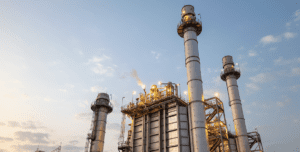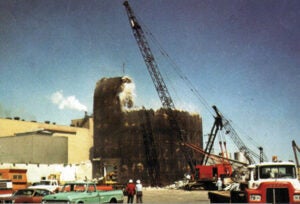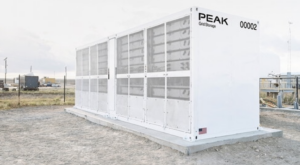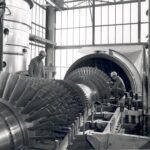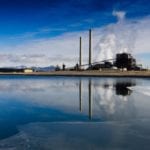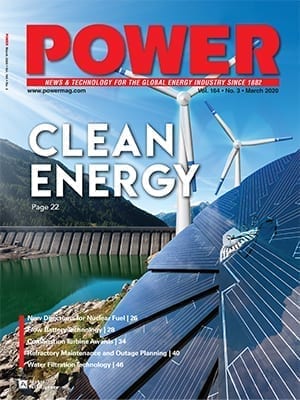The U.S. Environmental Protection Agency has proposed tougher nitrogen oxide (NOx) emissions limits for new, modified, and reconstructed stationary combustion turbines. The proposed rule identifies a combination of combustion controls and selective catalytic reduction (SCR) as the Best System of Emission Reduction (BSER) for most turbines though it proposes combustion controls alone for certain smaller or lower-load units.
The Nov. 22–issued proposed New Source Performance Standards (NSPS) rule, a first update since 2006, proposes to lower NOx standards of performance for most combustion turbine subcategories based on updated technical information. In addition, the EPA aims to ensure that new and reconstructed turbines firing or co-firing hydrogen meet the same NOx control levels as turbines using natural gas or non-natural gas fuels, adjusted for the percentage of hydrogen utilized. While it maintains current sulfur dioxide (SO₂) standards, the proposed rule also includes amendments to clarify existing regulations and address technical and editorial issues.
According to the EPA, the proposal will “ensure that new turbines especially large ones that could operate for decades-would be among the most efficient and lowest-emitting turbines ever built.” It also seeks to “provide environmental protection for communities alongside regulatory certainty for the power sector, supporting reliability authorities in the continued delivery of reliable and affordable electricity,” it said.
However, though the proposed rule could have implications for gas generators, its final promulgation remains uncertain amid the election of a Trump administration, which has historically rolled back similar environmental regulations.
A Brief History of the Rule
As POWER reported, the Biden administration has been crafting “comprehensive approach” to regulate “climate, toxic, and criteria air pollution” from “the entire fleet of natural gas-fired turbines.” The approach, announced on Feb. 29, 2024, stems from the agency’s move earlier this year to drop requirements covering existing natural gas-fired power plants in its April 2024–finalized Section 111 rule regulating power sector greenhouse gas (GHG) emissions (the Carbon Pollution Standards).
The proposed “Review of New Source Performance Standards for Stationary Combustion Turbines and Stationary Gas Turbines,” issued on Friday amends NSPS of stationary outlined under Subpart KKKK, which the EPA issued in 2006 to reflect advancements in combustion control technologies and the use of low-sulfur fuels as the BSER. The 2006 update also introduced subcategories for turbines, categorized by size, fuel type, and operating conditions, each with specific emission limits. As it currently stands, the 2006 rule sets a NOx emission standard ranging from 15 parts per million (ppm) to 42 ppm for new natural gas turbines.
But under the Clean Air Act, an EPA administrator is obligated to review and, if appropriate, revise the standards at least every eight years. In 2022, environmental groups sued the EPA to compel the administrator to perform his “nondiscretionary duty” to review Subpart KKKK and then proposed a consent decree that set a deadline for EPA action by November 2024, with a final rule completed in November 2025.
What Does the Proposal Include?
According to the EPA, stationary combustion turbines “are located at power plants and at industrial sources, such as pipeline compressor stations, chemical and manufacturing plants, oil fields, landfills, and institutional facilities, among others. They are used to produce electricity and to drive heavy equipment such as compressors.”
A stationary combustion turbine encompasses all components of a turbine system, including the combustion turbine itself, fuel, air, lubrication, exhaust systems, control systems (excluding emission controls), heat recovery systems like HRSGs, and ancillary components in simple, regenerative, or combined cycle configurations, as well as combined heat and power systems. It is defined as stationary when not self-propelled, though it may be mounted for portability.
The proposed rule will cover stationary combustion turbines with a heat input at peak load equal to or greater than 10.7 GJ/h (10 MMBtu/h), based on the higher heating value (HHV) of the fuel, that commence construction, modification, or reconstruction after the publication of this proposed rule in the Federal Register.
As set out in the proposal, the EPA outlines specific NOx standards tailored to the size, load, and fuel type of stationary combustion turbines. The rule classifies turbines by size—small (≤ 250 MMBtu/h), medium (> 250 and ≤ 850 MMBtu/h), and large (> 850 MMBtu/h)—and by load, distinguishing low load (≤ 20% capacity factor), intermediate load (> 20% and ≤ 40%), and base load (> 40%).
The EPA said that as part of its NSPS review, it evaluated dry combustion controls (for example, lean premix/dry low NOx [DLN] systems), wet combustion controls (e.g., water or steam injection), and post-combustion SCR to determine BSER for each of the subcategories of combustion turbines that burn natural gas.
Table 1: Proposed Subcategories and NOx Standards for Subpart KKKKa Source: EPA
Broadly, the rule proposes combustion controls as the BSER for turbines at low loads and combustion controls with post-combustion SCR for medium and large turbines operating at higher loads. The standards further account for fuel type, differentiating between natural gas, non-natural gas fuels, and hydrogen blends while exempting turbines from overlapping NSPS subparts to streamline compliance.
Table 2: Proposed EPA Turbine Classifications Source: EPA
EPA: Industry Is Already Mostly Compliant
According to the EPA’s Regulatory Impact Analysis, the proposed rule will apply to 4,365 combustion turbine units at 1,715 facilities—mostly for power generation (2,711 units at 968 facilities). But it will also cover combustion turbines in other industries, including oil and gas extraction, the natural gas distribution sector, and manufacturing sectors.
However, during the proposed rule’s implementation period (2025–2032), only about 251 new stationary combustion turbines will be installed in the U.S. and would be affected by the rule, the agency estimates. Of these, 153 will be in the power sector. “The agency anticipates that new combined cycle facilities (including combined cycle CHP facilities) would already have plans to install the controls proposed in this NSPS, though in some cases it is expected that the combined cycle turbines would have to upgrade and/or operate the controls more intensively to meet the proposed NSPS requirements in new subpart KKKKa,” it said.
The majority of new power-generating simple cycle turbines would, meanwhile, fall into the low-load subcategory and have “combustion controls consistent with the proposed standards and would not be impacted by the proposal,” it said. About 10% of simple cycle turbines would operate as intermediate load, but these, too would already have SCR. In all, relative to the historic baseline, only about “approximately 30 utility units” would be expected to incur additional costs under the new proposed limits.
SCR is “already widely adopted as an emissions control strategy for many types and sizes of stationary combustion turbines, with 100% of all new combined cycle units and approximately 75% of all new simple cycle units in the power sector installing SCR in the last 5 years,” the EPA noted.
Still, the measure could pose new costs for industry. If implemented by 2028 as envisioned, compliance costs could mount to $166 million in present value, including capital investments for SCR and operational adjustments to existing controls (such as increased monitoring and additional fuel or power requirements to support emission control systems). The EPA suggested uncertainties surround the economic impact, however, particularly for smaller turbines and industrial units, because costs could vary depending on turbine size, fuel use, and operational configurations.
However, the agency suggested the rule could yield significant environmental and health benefits by substantially reducing NOx emissions from stationary combustion turbines. The agency’s RIA suggests the new limits could decrease NOx emissions by 198 tons in 2027, scaling up to a reduction of 2,659 tons by 2032. The agency says the reductions are critical for mitigating adverse health effects, given that NOx contributes to the formation of fine particulate matter (PM2.5) and ground-level ozone.
The EPA also said it considered systemwide impacts, including for reliability. It said it engaged with major combustion turbine manufacturers—including Siemens Energy, GE, Mitsubishi, and Solar Turbines—as well as with industry trade groups, like the Gas Turbine Association. “Specifically, this included updates on any technology developments and cost estimates that would impact turbine performance and/or criteria pollutant emissions for most new models of available combustion turbines,” it said. Consultations also included representatives from state and local governments, environmental groups, and reliability organizations during forums and meetings, it said.
The agency’s evaluation also considered operational flexibility. The proposed rule, for example, includes provisions to ensure turbines needed during critical events remain operational without undue regulatory burdens. The EPA notes that electricity generated during system emergencies, such as those defined under NERC Energy Emergency Alert levels 2 or 3, would not count toward subcategorization thresholds.
—Sonal Patel is a POWER senior editor (@sonalcpatel, @POWERmagazine).



